Equigua Exam 3 Review
1/43
There's no tags or description
Looks like no tags are added yet.
Name | Mastery | Learn | Test | Matching | Spaced |
|---|
No study sessions yet.
44 Terms
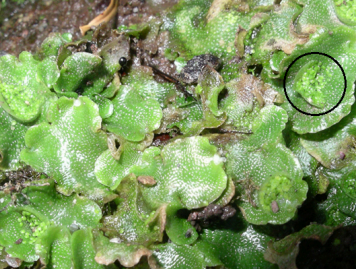
form a flat thallus, with lobes that have a vague resemblance to the lobes of the liver. The thallus allows the movement of gasses. It takes up water over its entire surface and has no cuticle to prevent desiccation, which explains their preferred wet habitats. Can reproduce sexually and asexually by the breaking of “branches” or the spreading of leaf fragments called gemmae: —small, intact, complete pieces of plant that are produced in a cup on the surface of the thallus
Liverworts
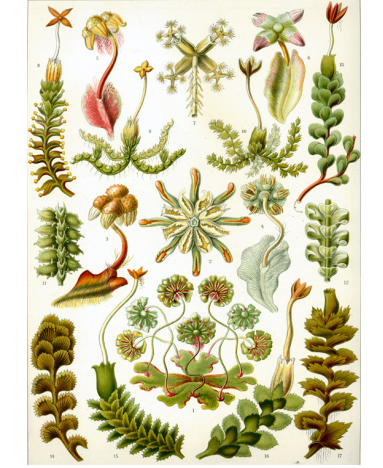
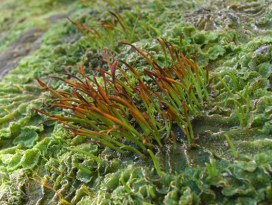
(Anthocerotophyta) characterized by a narrow, pipe-like sporophyte. The short, blue-green gametophyte is the dominant phase of its life cycle. The sporophytes emerge from the parent gametophyte and continue to grow throughout the life of this plant. Another unique characteristic is the growth pattern. Stomata are abundant in this plant and appear in the sporophyte. Photosynthetic cells in the thallus each contain a single chloroplast. Meristem cells at the base of the plant keep dividing and adding to the height of the sporophyte.
Hornworts
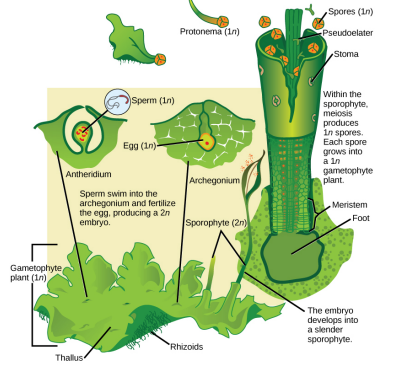
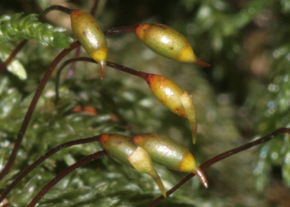
Green, flat structures with a simple midrib—resembling true leaves, but lacking stomata, vascular tissue and true root system—are attached in a spiral to a central stalk. They have stomata only on the sporophyte. Water and nutrients are absorbed directly through the leaflike structures of the gametophyte. A primitive conductive system that carries water and nutrients runs up the gametophyte's stalk, but does not extend into the leaves. Are anchored to the substrate—whether it is soil, rock, or roof tiles—by multicellular rhizoids, precursors of roots.
Mosses

the tissue responsible for the storage and long-distance transport of water and nutrients, as well as the transfer of water-soluble growth factors from the organs of synthesis to the target organs. The tissue consists of conducting cells, known as tracheids, and supportive filler tissue, called parenchyma. Xylem conductive cells incorporate the compound lignin into the walls of seedless tracheophytes.
Xylem (seedless tracheophytes)
the second type of vascular tissue; it transports sugars, proteins, and other solutes throughout the plant. Cells are divided into sieve elements (conducting cells) and cells that support the sieve elements.
Phloem (seedless tracheophytes)
extensive network that penetrates deep into the soil to reach sources of water also stabilizes plants by acting as a ballast or anchor. They establish a symbiotic relationship with fungi, forming mutualistic mycorrhizae, which benefit the plant by greatly increasing the surface area for absorption of water, soil minerals, and nutrients.
Roots (seedless tracheophytes)
Site of photosynthesis or photosynthesis efficiency
Leaves (seedless tracheophytes)
leaves that were modified structurally to bear sporangia. In conifers, the commonly named pine cones, strobili are cone-like structures that contain sporangia.
sporophylls (seedless tracheophytes)
they provide food and shelter for other plant species. In a hostile environment, like the tundra where the soil is frozen, bryophytes grow well because they do not have roots and can dry and rehydrate quickly once water is again available. Mosses are at the base of the food chain in the tundra biome. Some reports indicate that bryophytes make the soil more amenable to colonization by other plants. Because they establish symbiotic relationships with nitrogen-fixing cyanobacteria, mosses replenish the soil with nitrogen. Moss protects from pollution and ferns contribute to the environment by promoting weathering of rock, accelerating the formation of topsoil, and slowing down erosion as rhizomes spread throughout the soil. The water ferns of the genus Azolla harbor nitrogen-fixing cyanobacteria and restore this important nutrient to aquatic habitats.
what is the role of seedless plants in the ecosystem?
seeds and pollen are innovative structures that allowed seed plants to reduce or eliminate their dependence on water for gamete fertilization and development of the embryo, and to conquer dry land. Pollen grains are male gametophytes, which contain the sperm (gametes) of the plant. The cells are encased in a protective coat that prevents desiccation (drying out) and mechanical damage. Pollen grains can travel far from their original sporophyte, spreading the plant’s genes.
what were 2 major innovations that allowed seed plants to reproduce in the absence of water?
they are the male gametophytes, which contain the sperm (gametes) of the plant. The whole structure is protected from desiccation and can reach the female organs without depending on water. After reaching a female gametophyte, it grows a tube that will deliver a male nucleus to the egg cell. It grows or is taken into a fertilization chamber, where the motile sperm are released and swim a short distance to an egg.
what is the purpose of pollen grains?
To offer embryo protection, nourishment, and a mechanism to maintain dormancy for tens or even thousands of years, ensuring that germination can occur when growth conditions are optimal. They allow plants to disperse the next generation through both space and time.
what is the purpose of seeds?
Angiosperms produce their gametes in separate organs, which are usually housed in a flower. Both fertilization and embryo development take place inside an anatomical structure that provides a stable system of sexual reproduction largely sheltered from environmental fluctuations.
*** Angiosperms produce their gametes in separate organs, which are housed in a flower.
why do angiosperms bear flowers?
Following fertilization of the egg, the ovule grows into a seed. The surrounding tissues of the ovary thicken, developing into a fruit that will protect the seed and often ensure its dispersal over a wide geographic range.
***The fruit surrounds the ovule after fertilization of the egg.
why do angiosperms bear fruit?
Gymnosperm
naked seeds, separate female and male gametophytes, pollen cones and ovulate cones, pollination by wind and insects, and tracheids (which transport water and solutes in the vascular system) are all characteristics of?
Modern-day Gymnosperms: Conifers (Coniferophyta)
tall trees that bear scale-like or needle-like leaves. Water evaporation from leaves is reduced by their narrow shape and a thick cuticle. Snow easily slides off needle-shaped leaves which is why they thrive in cold climates.
Ex: Pines
Modern-day Gymnosperms: Cycads
thrive in mild climates such as the Encephalartos ferox which bears cones & are pollinated by beetles
Modern-day Gymnosperms: Ginkgophytes
has fan shaped leaves. These seed plants turn yellow in autumn and fall from the tree
Ex: Ginkgo biloba
Modern-day Gymnosperms: Gnetophytes
found in dry areas such as Mexico. Has scale-like leaves and is used for medicine as decongestant.
Ex: Ephedras
The success of angiosperms is due to two novel reproductive structures: flowers and fruits. The function of the flower is to ensure pollination, often by arthropods, as well as to protect a developing embryo. The colors and patterns on flowers offer specific signals to many pollinating insects or birds and bats that have coevolved with them. Flower scent also helps to select its pollinators. Flowers also provide protection for the ovule and developing embryo inside a receptacle.
The function of the fruit is seed protection and dispersal.
why are angiosperms the dominant form of plant life?
Flower part: Sepals
modified leaf that encloses the bud; outermost structure of a flower
Flower part: Petal
modified leaf interior to the sepals; colorful petals attract animal pollinators
Flower part: Stamen
structure that contains the male reproductive organs
Flower part: Carpels:
female reproductive structures that produce egg cells and protect a developing baby plant, or embryo.
Many authors have attributed the diversity of plants and insects to both pollination and herbivory, or the consumption of plants by insects and other animals. To “combat” herbivores, some plant seeds—such as acorn and unripened persimmon—are high in alkaloids and therefore unsavory to some animals. Herbivory has been exploited by seed plants for their own benefit. The dispersal of fruits by herbivorous animals is a striking example of mutualistic relationships. The plant offers to the herbivore a nutritious source of food in return for spreading the plant’s genetic material to a wider area.
Ex: Acacia trees and acacia ants.
how angiosperm diversity is due, in part, to multiple complex interactions with animals
wind pollination
Flowers pollinated by wind are usually small, feathery, and visually inconspicuous. Grasses are a successful group of flowering plants that are wind pollinated. They produce large amounts of powdery pollen carried over large distances by the wind. Some large trees such as oaks, maples, and birches are also wind pollinated.
animal pollination
(the transfer of pollen from the anther to the stigma)
Many bird or insect-pollinated flowers secrete nectar, which is a sugary liquid. They also produce both fertile pollen, for reproduction, and sterile pollen rich in nutrients for birds and insects. Pollinating insects such as butterflies collect nectar while at the same time are dusted with pollen (Figure 26.21).
Biodiversity ensures a resource for new food crops and medicines. Plant life balances ecosystems, protects watersheds, mitigates erosion, moderates our climate, and provides shelter for many animal species.
what roles do plants play in ecosystems?
The explosion of the human population and increasing birth rates is leading to devastating human encroachment into forested areas. To feed the growing population, humans need to obtain arable land, so there has been and continues to be massive clearing of trees. The number of plant species becoming extinct is increasing at an alarming rate. Because ecosystems are in a delicate balance, and seed plants maintain close symbiotic relationships with animals—whether predators or pollinators—the disappearance of a single plant can lead to the extinction of connected animal species.
how does deforestation threaten plant biodiversity?
3 regions of plant growth: Apical meristems
contain meristematic tissue located at the tips of stems and roots, which enable a plant to extend in length
3 regions of plant growth: Lateral meristems:
facilitate growth in thickness or girth in a maturing plant
3 regions of plant growth: Intercalary meristems
-occur only in monocots, at the bases of leaf blades and at nodes (the areas where leaves attach to a stem)
-enables the monocot leaf blade to increase in length from the leaf base
Dermal tissue
covers and protects the plant
Consists of epidermis, contains stomata (opening for exchange of gasses) and guard cells (control what goes in and out)
Vascular tissue
transports water, minerals, and sugars to different parts of the plant. Xylem and Phloem make up vascular tissue (arranged in distinct strands called vascular bundles)
Ground tissue:
serves as a site for photosynthesis, provides a supporting matrix for the vascular tissue, and helps to store water and sugars. (made up of parenchyma cells, collenchyma & sclerenchyma cells).
Stem: Primary growth
The increase in length of the shoot and the root. It is the result of cell division in the shoot apical meristem. Subsequent cell elongation also contributes to primary growth. The growth of shoots and roots during primary growth enables plants to continuously seek water (roots) or sunlight (shoots). Herbaceous plants mostly undergo primary growth, with hardly any secondary growth or increase in thickness.
Stem: Secondary growth
is characterized by an increase in thickness or girth of the plant, and is caused by cell division in the lateral meristem. Secondary growth or “wood” is noticeable in woody plants; it occurs in some dicots.
Tap root system
has a main root that grows down vertically, and from which many smaller lateral roots arise. Dandelions are a good example; their tap roots usually break off when trying to pull these weeds, and they can regrow another shoot from the remaining root. A tap root system penetrates deep into the soil. Dicots
fibrous root system
is located closer to the soil surface, and forms a dense network of roots that also helps prevent soil erosion (lawn grasses are a good example, as are wheat, rice, and corn). Monocots
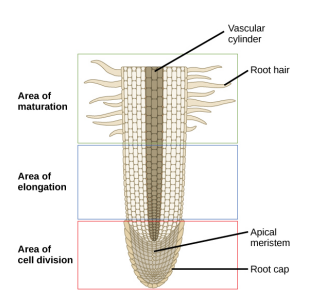
zones of the root tip: zone of cell division
closest to the root tip; it is made up of the actively dividing cells of the root meristem.
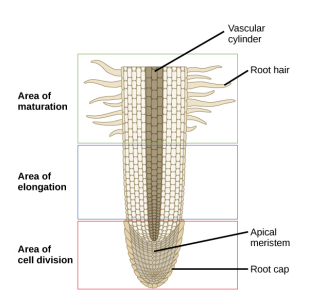
zones of the root tip: zone of elongation
is where the newly formed cells increase in length, thereby lengthening the root.
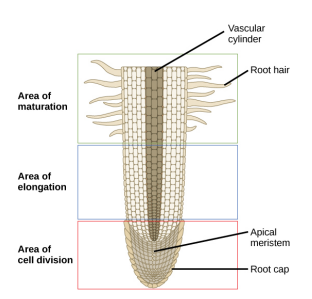
zones of the root tip: zone of cell maturation
Beginning at the first root hair where the root cells begin to differentiate into special cell types.
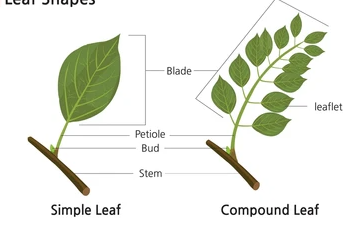
simple leaf
the blade is either completely undivided—as in the banana leaf—or it has lobes, but the separation does not reach the midrib, as in the maple leaf.
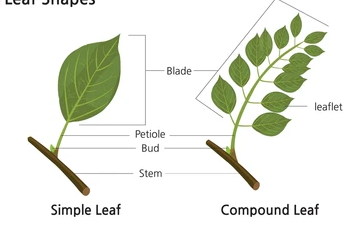
compound leaf
leaf blade is completely divided, forming leaflets, as in the locust tree. Each leaflet may have its own stalk, but is attached to the rachis.